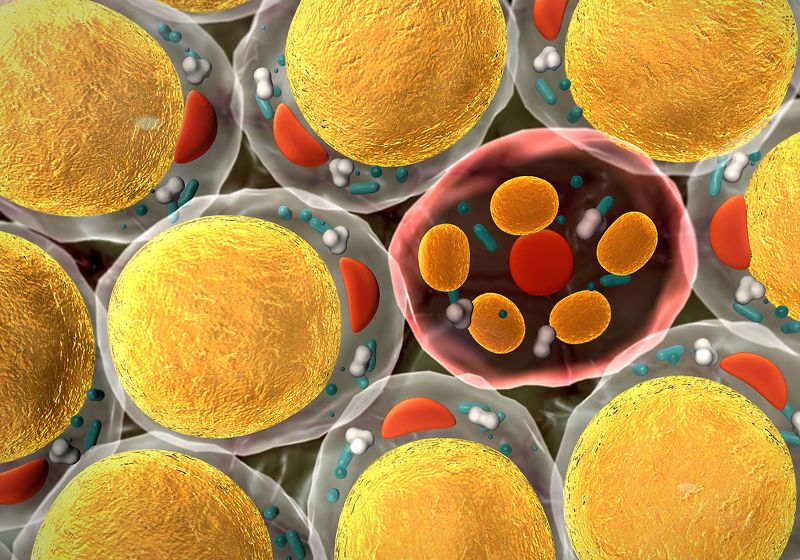Was Lamarck Right? Reviving a Dead Theory of Evolution

A random mutation in a gene can alter its function and bring about a new characteristic that can pass down for many generations, but this may not be the only way that organisms can inherit a trait. People can acquire characteristics during life, such as improved strength from training or changes in body weight affected by diet. Naturalists wondered if acquired traits like these were heritable, but scientists struggled to demonstrate this hypothesis experimentally, leading to its dismissal. However, emerging data suggests that some acquired traits are passed on, if only to a small extent.
In at least three historical famines, people felt the impact of starvation decades after the food shortage ended. Young children who survived through a bad harvest in the remote Swedish town of Överkalix in 1867 grew up to have children and grandchildren that lived six years longer than the average life expectancy.1 Pregnant women struggling through historical famines in the Netherlands and China gave birth to offspring with health problems such as increased body weight, type 2 diabetes, and kidney diseases.2 Intriguingly, once the offspring grew up, they passed on their famine-acquired health effects to the next generation, even though the food shortages had long since vanished. With ongoing famines in war-torn places like Gaza, South Sudan, and Sudan, there is an urgent need to understand how health effects acquired throughout life can prevail for generations to come.
Now, scientists are exploring how organisms can pass on epigenetic traits, which are features that contribute to an individual’s phenotype without altering the underlying gene sequence. Epigenetic changes include methyl groups tagged onto DNA, modifications to the histones that wrap DNA, and the breakdown of mRNA transcripts to silence genes. Though scientists have yet to unravel the precise mechanisms behind epigenetic inheritance, recent evidence reveals noncoding RNA could be pivotal to passing on acquired traits, and a novel hypothesis suggests epigenetic markers in sex stem cells may also play a role.
Lamarckism and the Inheritance of Acquired Traits
The theory that acquired traits could be inherited dates back at least as far as Aristotle and Hippocrates.3 Charles Darwin even hypothesized that different tissues in the body might secrete organic particles called “gemmules” that come together in the gonads, where sex cells develop, to pass on acquired traits.4 German naturalist Ernst Haeckel proposed a similar theory but called his organic particles “plastidules.”5
The theory that acquired traits could pass down generations is most often associated with 19th century French naturalist Jean Baptiste de Lamarck.
©iStock, AugustineChang
However, the theory that acquired traits could pass down through generations is most often associated with 19th-century French naturalist Jean Baptiste de Lamarck. In his 1809 book, “Zoological Philosophy,” he outlined his theory, which later became known as “Lamarckism.”6 He proposed that animals adapt their morphology to survive and pass on these traits to their offspring. He proposed how aquatic birds that catch prey in water adapt to avoid sinking into the mud: “This bird, wanting to ensure that its body does not dive into the liquid, makes every effort to lengthen its feet,” and passes its adaptation onto its breed.
Today, scientists know that such overt morphological changes cannot pass down generations, but Lamarck couldn’t have known this at the time. “Lamarck lived well before the setting up of genetics, so he had absolutely no ideas about genes, about Mendelian factors, and of course, absolutely no possible knowledge of molecular biology,” said Laurent Loison, a science historian at the National Center for Scientific Research.
As scientists began to unravel how genes control inheritance, they discovered that genetics controls heredity for the most part. Evidence for Lamarckism, on the other hand, was absent. However, scientists lacked a framework to test Lamarckism because, with cell biology in its infancy, they couldn’t propose a mechanism for how acquired traits might pass on. Instead, they hastily ruled out the inheritance of acquired traits based on a handful of experiments: German scientist August Weismann cut off the tails of mice to see if they would pass on their injury to their pups, but they did not.7 Darwin’s half cousin, Francis Galton, transfused blood between rabbits with different coat colors to see if the recipients’ kittens would inherit the donors’ coat color, but the experiment similarly failed.8 Arshak Alexanian, an epigenetics researcher at the Medical College of Wisconsin, considered these to be “very primitive experiments” that could not be used to dismiss Lamarckism. A common logical fallacy is to mistake an absence of evidence for a hypothesis as evidence for its absence, yet scientists used these scant experiments to rule out the inheritance of acquired traits. “At that time, nothing was known about gene regulation and epigenetics, yet they made such a conclusion. And unfortunately, it became dogma,” Alexanian said.
New Theories of Epigenetic Inheritance
In the late 20th century, when researchers began to use molecular biology techniques to understand the workings of the cell, they realized that modifications to DNA that do not alter gene sequences could affect gene expression and therefore an organism’s characteristics. Cells can acquire these epigenetic changes such as DNA methylation or histone acetylation in response to environmental stimuli and can pass these changes on to daughter cells, suggesting epigenetics may provide a mechanism by which acquired traits can be inherited.9
Noncoding RNA molecules are considered epigenetic regulators because they can interfere with gene expression without disrupting DNA sequences.10 Some complement mRNA gene transcripts and pair with them, creating double-stranded RNA complexes that the cell breaks down, preventing ribosomes from using the mRNA to make protein. Others latch onto mRNA to block splicing, the process by which noncoding introns are removed before the mRNA is translated into protein. RNAs can also modify methylation tags on DNA by interacting with methylase enzymes, which can affect how transcription enzymes and histones bind to the gene.11
Given that noncoding RNAs can lead to epigenetic changes in multiple ways, scientists think they could potentially be heritable epigenetic regulators. So far, researchers have demonstrated that these RNAs can travel to sex organs from other body tissues, much like the hypothetical gemmules and plastidules that Darwin and Haeckel proposed. By injecting Green Fluorescent Protein-tagged RNA into the mouse bloodstream, scientists could trace the molecules to sperm cells.12 Next, scientists will need to prove whether these RNAs are heritable and pass down to offspring.
RNA doesn’t last as long as DNA, in part because the cell carries numerous enzymes to break down old RNA transcripts. For RNA to pass down generations, it would need to resist its degradation. In a study from September 2024, researchers found a potential solution in mice and the model plant Arabidopsis.13 They observed that some RNA molecules underwent chemical modifications to convert the RNA building block uridine into pseudouridine. This modification was more prominent among RNA molecules held within sex organs, suggesting that these RNAs might influence epigenetic changes in offspring. The researchers argued that the pseudouridine modifications could render the RNA undetectable by RNA-cleaving enzymes, allowing them to prevail in progeny, where they could exert effects on future generations.
Alexanian argued that small RNAs might not be sufficient to pass on complex acquired traits and suggested that other factors could be involved too. In 2024, he proposed a new, elaborate hypothesis that has yet to be tested.14 Building on studies showing that sperm stem cells can be reprogrammed into neurons and heart cells in vitro, he suggested that the sperm stem cells might migrate to tissues through blood circulation, differentiate into body cells where they can acquire epigenetic changes, like DNA methylation tags or histone modifications, in response to different environmental stimuli.15,16 Then, they might migrate back to the testes, dedifferentiate back into stem cells while retaining those epigenetic changes and convert into sex cells that can pass on those epigenetic markers. Since female animals are typically born with a set of nearly-differentiated egg cells, called the ovarian reserve, they could not pass on traits acquired throughout life via this stem cell-based mechanism.17
Scientists have demonstrated in vitro that pluripotent stem cells can convert into the progenitors of sex cells when mixed with hormones like testosterone and other stem cell differentiation factors.18,19 Research also shows that these progenitors can migrate across the blood-testis barrier, suggesting they may derive from cells outside the gonads.20 However, to provide more credence to Alexanian’s new theory, researchers would need to demonstrate inside the body rather than in a test tube that stem cells outside the gonads readily differentiate into sex cells, and they would need to directly observe that they migrate from the bloodstream into the testes. However, unless more researchers reconsider the possibility that acquired traits can pass on, Alexanian fears this work will hit a roadblock. “Because of the dogma, nobody is interested in this, and even then, nobody will fund such research,” he lamented.
Epigenetic Inheritance Differs in Nature
While examples of epigenetic inheritance pop up throughout the natural world, the inheritance of acquired traits through epigenetics doesn’t affect all organisms equally. Epigenetic inheritance is often seen in plants. For example, the hypermethylation of the Cnr gene in tomatoes blocks their ripening, and this epigenetic programming can transmit to new plants.25 It’s also more common in invertebrates, such as the model worm Caenorhabditis elegans and the water flea Daphnia, than vertebrates. In March of this year, scientists found that exposure to a bacterial pathogen in one generation decreased the fitness in subsequent generations of water fleas.24
However, in some vertebrates, including mice and humans, the body erases epigenetic markers at different stages of development.22
“In mammals, you have at least two different mechanisms that are responsible for the eradication of epigenetic markers, the first during gametogenesis (sex cell production) and the second at the very beginning of embryological development” once two sex cells fuse and form a fertilized egg, Loison explained. He added that “these mechanisms are absolutely necessary because if you don’t erase the epigenetic markers, then the development is unable to succeed.” However, “these mechanisms are not completely efficient, so you have some markers that could be transmitted,” he said.
Scientists have found evidence that some epigenetic markers can prevail past these erasures. For instance, mice conditioned to fear an odor passed on that fear for two generations through hypomethylation—decreased DNA methylation—of an olfactory gene called Olfr151.23 A more famous example involves the Agouti gene for coat color, which produces a yellow coat in mice when overexpressed and a brown coat when silenced. Brown- and yellow-coated mice have the same gene sequence, but a transposon located near the gene that promotes its activation is epigenetically switched “off” in the brown-coated mice but not in the yellow-coated ones. Given that epigenetic markers control coat color, and since mice tend to pass on the same color to their pups, scientists realized that epigenetic changes at the Agouti locus pass down generations.
Epigenetics and Future Health
Since acquired traits could affect health, as they did in the famine cohorts, this mode of inheritance is worth further study, argued Bertrand Joseph, a cell biologist at the Karolinska Institute in Sweden. The young children enduring famine in Överkalix passed on traits for longer lifespan to their offspring, and Joseph thinks this is related to epigenetic changes in autophagy—the body’s mechanism for recycling old cellular parts, which may prove essential when food becomes less available.2 Autophagy tends to decline with age except in centenarians, so it’s upregulation could be important to prolonging life.26 “I’ve shown that in animals, if you induce autophagy by food restriction, you will have beneficial effects on lifespan,” Joseph said. “Our lab has been showing that when you induce autophagy, you have some epigenetic mechanisms induced,” he added. “We know that this type of modification can be inherited to the next generation.”
Pregnant women struggling through historical famines in the Netherlands and China gave birth to offspring with health problems. Once the offspring grew up, they passed on their famine-acquired health effects to the next generation, even though the food shortages had long since vanished.
©iStock, photomaru
In contrast to young children enduring the Swedish famine that acquired longer lifespans, fetuses in the womb surviving the Dutch and Chinese famines acquired negative health traits that they passed to their offspring. With the current famines in Gaza, South Sudan, and Sudan, “It’s not only them that are going to be affected. Their offspring will also be affected and that we should take into account,” Joseph said. Scientists still aren’t sure for how many generations an acquired trait can last. Health effects persist for at least two generations in the famine cohorts, but Joseph explained that it’s challenging to track successive generations because of human migration. In plants too, scientists have only traced epigenetic inheritance for up to eight generations, Loison said.21
Does evidence of epigenetic inheritance vindicate Lamarck? “There is no absolute answer to this question, but my opinion is that mostly it does not,” Loison said. “Back in the 19th century, the inheritance of acquired characteristics was understood as the normal way of inheritance,” he explained. “The main difference (today) is that epigenetic inheritance is quite weak.”
Lamarck was wrong to think that traits acquired throughout life represented the main source of heritable variation, but epigenetics data has shown that acquired traits can transmit down generations occasionally. Joseph added that if researchers begin exploring the epigenome more closely, they may start to spot heritable changes linked to disease that are lost when looking at genes alone.
- Kaati G, et al. Transgenerational response to nutrition, early life circumstances and longevity. Eur J Hum Genet. 2007;15(7):784-790.
- González-Rodríguez P, et al. The hunger strikes back: An epigenetic memory for autophagy. Cell Death Differ. 2023;30(6):1404-1415.
- Poczai P, Santiago-Blay JA. Chip off the old block: Generation, development, and ancestral concepts of heredity. Front Genet. 2022;13:814436.
- Liu Y, Chen Q. 150 years of Darwin’s theory of intercellular flow of hereditary information. Nat Rev Mol Cell Biol. 2018;19(12):749-750.
- Levit GS, Hossfeld U. Natural selection in Ernst Haeckel’s legacy. In: Natural Selection. Vol 3. Evolutionary Biology – New Perspectives on Its Development. Springer International Publishing; 2021:105-133.
- de Lamarck JB. Philosophie zoologique. 1873.
- Gauthier P. Does Weismann’s experiment constitute a refutation of the Lamarckian hypothesis?JSTOR. 1990;61(1/2):6-8.
- Liu Y. A new perspective on Darwin’s Pangenesis. Biol Rev. 2008;83(2):141-149.
- Lacal I, Ventura R. Epigenetic inheritance: Concepts, mechanisms and perspectives. Front Mol Neurosci. 2018;11:292.
- Cecere G. Small RNAs in epigenetic inheritance: From mechanisms to trait transmission. FEBS Letters. 2021;595(24):2953-2977.
- Di Ruscio A, et al. DNMT1-interacting RNAs block gene-specific DNA methylation. Nature. 2013;503(7476):371-376.
- Cossetti C, et al. Soma-to-germline transmission of RNA in mice xenografted with human tumour cells: Possible transport by exosomes. PLoS ONE. 2014;9(7):e101629.
- Herridge RP, et al. Pseudouridine guides germline small RNA transport and epigenetic inheritance. Nat Struct Mol Biol. 2025;32(2):277-286.
- Alexanian AR. Epigenetic inheritance of acquired traits via stem cells dedifferentiation/differentiation or transdifferentiation cycles. Cells Dev. 2024;179:203928.
- Glaser T, et al. Adult germ line stem cells as a source of functional neurons and glia. Stem Cells. 2008;26(9):2434-2443.
- Guan K, et al. Generation of functional cardiomyocytes from adult mouse spermatogonial stem cells. Circ Res. 2007;100(11):1615-1625.
- Monniaux D. Factors influencing establishment of the ovarian reserve and their effects on fertility. Anim Reprod. 2018;15:635-647.
- Xu H, et al. Derivation and propagation of spermatogonial stem cells from human pluripotent cells. Stem Cell Res Ther. 2020;11(1):408.
- Hwang YS, et al. Reconstitution of prospermatogonial specification in vitro from human induced pluripotent stem cells. Nat Commun. 2020;11(1):5656.
- Takashima S, et al. Rac mediates mouse spermatogonial stem cell homing to germline niches by regulating transmigration through the blood-testis barrier. Cell Stem Cell. 2011;9(5):463-475.
- Loison L. Lamarckism and epigenetic inheritance: A clarification. Biol Philos. 2018;33(3-4):29.
- Loison L. Epigenetic inheritance and evolution: A historian’s perspective. Phil Trans R Soc B. 2021;376(1826):20200120.
- Wu Y. A study about piRNA’s requirement in transgenerational memory in mice induced by odor-fear conditioning and AI analysis. In: Proceedings of the 2nd International Symposium on Artificial Intelligence for Medicine Sciences. ACM; 2021:162-167.
- Shahmohamadloo RS, et al. Transgenerational epigenetic inheritance increases trait variation but is not adaptive. Evolution. 2025;79(6):1033-1043.
- Zhu H, et al. Epigenetic insights into an epimutant colorless non-ripening: From fruit ripening to stress responses. Front Plant Sci. 2024;15:1440120.
- Xiao FH, et al. Transcriptome evidence reveals enhanced autophagy-lysosomal function in centenarians. Genome Res. 2018;28(11):1601-1610.




